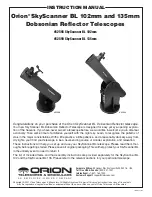
4
secondary mirror, and the reflection of the secondary mirror is
centered in the reflection of the primary mirror (behind the
central black circle).
A simple star test will tell you whether the optics are
accurately collimated.
Star-Testing Your Telescope
When it is dark, point the telescope at a bright star and cen-
ter it in the eyepiece’s field-of-view (with the right ascension
and declination slow-motion controls on your equatorial
mount). Slowly rack the image out of focus with the focusing
knob. If the telescope is correctly collimated, the expanding
disk should be a perfect circle. If it is unsymmetrical, the
scope is out of collimation. The dark shadow cast by the sec-
ondary mirror should appear in the very center of the
out-of-focus circle, like the hole in a doughnut. If the “hole”
appears off-center, the telescope is out of collimation.
Cooling the Telescope
All optical instruments need time to reach “thermal equilibri-
um” to achieve maximum stability of the lenses and mirrors,
which is essential for peak imaging performance. When
moved from a warm indoor location to cooler outdoor air, a
telescope needs time to equilibrate to the outdoor tempera-
ture. The bigger the instrument and the larger the
temperature change, the more time is needed.
For your Argonaut 6", allow at least one hour for temperature
equilibration. If the scope has to adjust to more than a 40° tem-
perature differential, allow two to four hours. In the winter, storing
the telescope outdoors in an enclosed shed or garage greatly
reduces the amount of time needed for the optics to stabilize.
4. Using the Telescope
Your Orion Argonaut 6" Maksutov-Newtonian telescope
yields high-quality images, yet is very easy to use. You will be
surprised at the simplicity of operation and the exceptional
optical performance. To get the most out of your telescope,
read this section carefully.
Mounting Options
For astronomy we highly recommend a sturdy equatorial
mount. If you have purchased the #21481 package, then you
already have an excellent equatorial mount to use with your
Argonaut 6". Refer to the instructions that come with the GP-
DX Equatorial Mount for details on how to properly use it.
The Argonaut 6" comes with a standard mounting plate
attached to the tube rings. The plate has two holes in it for
attaching the telescope to an equatorial mount (we supply a
separate mounting plate for use with the GP-DX mount). If
the two holes do not line up with the bolts on your equatorial
mount’s head, you may need to have new holes drilled in the
plate. We suggest contacting a local machining or metal
working shop for this. Alternatively, the tube rings themselves
have threaded mounting holes in them; you can remove the
mounting plate and connect the tube rings directly to an
equatorial mount’s head.
Focusing the Telescope
The Argonaut 6" is equipped with a 2" Crayford-type focuser that
smoothly moves the focuser drawtube in and out. If you are using
1.25" eyepieces, you must first insert a 2"-to-1.25" adapter (Orion
item #8768) into the drawtube. Then insert an eyepiece into the
focuser and secure it with the thumbscrew on the drawtube.
To test the focusing procedure, look through the eyepiece and find
a bright star or a land object over a quarter-mile away. Center it in
the field of view. Now, using your fingers, slowly rotate one of the
focusing knobs until the object comes into sharp focus. The
Argonaut 6" has a minimum focusing distance of about 100 yards.
There are two thumbscrews on the underside of the focuser.
The one nearest to the drawtube adjusts the focusing ten-
sion. Tighten this thumbscrew finger-tight so the drawtube
moves in and out smoothly and easily when the focus knob is
rotated. This thumbscrew may need to be readjusted when
changing to a heavier or lighter eyepiece. The other thumb-
screw locks the focuser drawtube in place.
Aligning the Finder Scope
The finder scope and the telescope should be aligned to point
to exactly the same spot in the sky. Alignment is easiest to do
in daylight hours, before your observing session. Choose a
treetop, telephone pole, street sign—anything that is far off in
the distance, at least a quarter-mile away. Put that image in
the center of the field of your telescope’s eyepiece. Where is
it in your finder scope’s eyepiece? Hopefully, the image will
be in the field of view and some simple adjustments of the
alignment screws of the finder scope bracket will put the
image dead-center in the crosshairs. Otherwise, coarser
adjustments to the alignment screws will be necessary. Focus
the finder scope by rotating its eyepiece assembly.
By loosening one alignment screw and tightening another,
you can change the line of sight of the finder scope. Continue
making adjustments to the alignment screws until the image
in both the finder scope and the telescope’s eyepiece are
exactly centered. Check the alignment by moving the main
telescope to another object and fixing the finder scope’s
crosshairs on the exact point you want to look at. Then, look
through the telescope’s eyepiece to see if that point is cen-
tered in the field of view. If it is, the job is done. If not, make
the necessary adjustments until the two images match up.
Finder scopes often come out of alignment during trans-
portation of the telescope from site to site, so check the
alignment before each observing session.
Eyepiece Selection
Always start viewing with your lowest-power, widest-field
eyepiece. After you’ve located and looked at the object with a
low-power eyepiece, switch to a higher-power eyepiece and
see if the object looks better or worse. Keep in mind that at
higher power, an image will always be fainter and less sharp
(this is a fundamental law of optics). Many observers use the
lowest-power eyepiece practically all the time. Naturally, high-
er magnifications are desirable for viewing some celestial
objects, but stay with low powers when searching for an
object and for extended viewing.



















